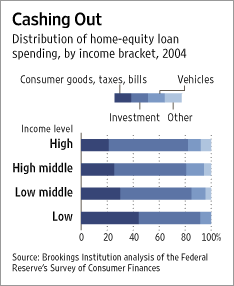“Subprime Pullback May Crimp Consumer Spending,” reads a headline from yesterday’s Wall Street Journal. Ya think? What is interesting to me is that the authors chose the word, “May,” rather than, “Will Crimp Consumer Spending.”
By definition, a credit contraction (and, make no mistake, that is exactly what is underway right now) means there will be less money floating around to spend. Period. Stagnating home prices (at best) mean less home equity to cash-out which translates to less spending. It also translates to less, “investing.” If you are considering an equity loan make sure that you check out the facts of equity release to ensure you have the correct knowledge going forward.
What really caught my eye in the article was this chart:

It shows that roughly 50% of home equity loans over the past few years have been used for, “investment.” The article tells us that “investments,” include, “home renovations and education,” but fails to specify how much of each and what else, exactly, comprises the category.
I think it’s safe to assume that home equity, “investment,” also applies to the classical definition of the word and means that cash-outs have recently been used to purchase traditional stock and bond, “investments,” along with, “investment” property.
We all know people who levered up using home equity to speculate in real estate. “Pull that equity out. It’s not doing anything for you. Put it to work. Buy more!” That was the m.o. of the real estate bubble. Some used this process to lever up to astounding levels buying multiple, “investment properties.”
With less equity to cash out, this process is dying. This is another aspect of the coming real estate vicious cycle I have written about: Less equity means fewer cash-outs which dampens demand further putting downward pressure on prices that leads to declining equity, etc. etc.
Other people, however, used the cash-out money to buy stocks. In fact, over 2 years ago, the NASD was so worried about people speculating in stocks with their home equity that they thought it prudent to warn them about the risks of excess leverage. (There was no real estate regulator, however, giving a similar warning. Any warnings out there were of the, “don’t miss the bonanza; don’t be left behind!” variety.)
With such a large chunk of home equity loans going toward additional speculation in real estate and the stock market it’s no surprise the NASD was worried. Now that cash-outs are disappearing, there Will be consequences. The slow-motion credit crunch now underway Will crimp consumer spending And investment. We’ll just have to wait and see to what degree.
LIV